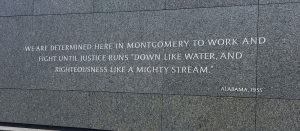
With the retirement of Dr. Tom Sims, Deputy Dean of the University of Delaware’s College of Agriculture and Natural Resources, I am pleased to be appointed the third Director of the Delaware Water Resources Center (DWRC). Dr. Sims skillfully served as the DWRC director for a decade and a half and made a real and substantial difference in the careers and lives of hundreds if not thousands of students, faculty, and staff who conducted research in water science and policy here at the University of Delaware. The DWRC is one of the 54 National Institutes for Water Resources (NIWR) supported by the U.S. Geological Survey at land grant universities in the 50 states, District of Columbia, and three island territories. The DWRC celebrates our 50th anniversary of the center’s designation at the University of Delaware in 1965, one year after Lyndon Baines Johnson signed the Water Resources Research Act (WRRA) on July 17, 1964. The DWRC belongs to the mid-Atlantic NIWR region that includes our colleagues at Cornell, Penn State, Rutgers, Maryland, Virginia Tech, and West Virginia.
By its favorable geography and hydrology, the University of Delaware is fortuitously situated for water resources research. The Newark campus along the fall line between the Appalachian Piedmont and Atlantic Coastal Plain, and the coastal Lewes campus along the Atlantic Ocean sit amidst two great estuary systems – the Delaware and Chesapeake. These mid-Atlantic basins contribute drinking water to a full one-tenth of the nation’s population and the first (New York City), fourth (Baltimore/DC), and seventh (Philadelphia) largest metropolitan economies in the United States. The White Clay Creek National Wild and Scenic River flows through the University of Delaware here in Newark as an ideal experimental watershed for on-campus water resources research by students and faculty/staff. One of our objectives is to increase the amount of federal, state, local, and foundation support for internships and research assistantships for students and faculty to conduct water resources research here in Delaware, the Delaware Valley, and throughout America.
If you are on campus, please feel free to drop by our offices at the DGS Annex, 261 Academy Street in Newark or contact me at 302-831-4929, jerryk@udel.edu or follow me on twitter @JerryUDwater.
Warmly,
Director, Delaware Water Resources Center
Gerald Joseph McAdams Kauffman CV (Mar 2023) (pdf)
UDWRC Water News Vol 21 No 1 (Oct. 2023)(pdf)
White Paper U.S. Water and Climate Change Policy (Jan 21, 2021 and rev. Mar 17, 2021) (pdf)
New Jersey Certified Public Manager Program (1987-88)
- S4E and EOEC Earth Week Research Panel (April 19, 2023) (mp4)
- S4E and EOEC Earth Week Research Panel (April 19, 2023) (pdf)
- Upstream Alliance Celebrity Check In, Restoration of the Nation’s Founding Fish in America’s Most Historic Small Watershed (Dec 16, 2020) (pdf)
- Climate Change, Diversity, and Resilience: Three Great Challenges of our Watershed. Presentation by Gerald Kauffman to the Water Resources Association of the Delaware River Basin (WRADRB) (Dec. 15, 2020) (pdf)
- Video: Earth Day 50 Year Golden Anniversary Celebration with Dr. Gerald Kauffman
- UCOWR in the spotlight: University of Delaware Water Resources Center (Oct. 2017)
- The Universities Council on Water Resources presents – Hydropolitics: Challenges in Intergovernmental River Basin Management, Southern Illinois University (March 2018) (pdf)
- Brandywine Christina America’s Most Historic Small Watershed (May 2018) (pdf)
- Economic Value of Nature and Ecosystems in the Delaware River Basin SPPA Connect Vol. 9 No. 1 (May 2018) (pdf)
- Water Quality Trends in the Brandywine Christina Cluster along the Arc Boundary of Delaware (Nov 2018) (pdf)
- WHYY Telecast with Dr. Jerry Kauffman
-
Op-Ed Columns
- The Delaware Way could be the national key to tackling climate change (Sunday New Journal, Apr 25, 2021) (pdf)
- We need to continue the Delaware River Renaissance (Dec 1, 2019) (pdf)
- Clean Water Rule keeps states safe (July 16, 2017) (pdf)
- First State’s future depends on healthy water (Mar 12, 2014) (pdf)
- The Delaware is an economic and ecological treasure (Oct 27, 2013) (pdf)
- The beauty of the historic Brandywine Valley (Sep 4, 2012) (pdf)
- Delaware Estuary needs renewed focus, protection (Aug 2, 2010) (pdf)
- The economics of water in Del (Apr 3, 2009) (pdf)
- Extreme storms are call for air quality (Dec 20, 2007) (pdf)
- A modest proposal for Newark’s central park (Nov 9, 2007) (pdf)
- Watershed moments continue (Jul 18, 2004) (pdf)
- Politics Muddies Waters (Mar 17, 2002) (pdf)
- Like the Teams, Cities Also Must Compete (Jan 9, 2001) (pdf)
The Director’s Corner
December 2024
UDWRC Director’s Message
Dr. Gerald Joseph McAdams Kauffman, Jr., Director University of Delaware Water Resources Center
The Golden Age of Water (1964-2024)
The year was 1964. It was a year the United States was embroiled in Vietnam. It was the year of the British Invasion before the Beatles played at Shea Stadium. And it was the year that Lyndon Baines Johnson who embraced the civil rights policies of his predecessor John Fitzgerald Kennedy signed the Civil Rights Act on July 2, 1964 after Congress passed it by a 2 1/2 to 1 margin in the House of Representatives and 3 to 1 in the Senate that outlawed discrimination based on race, color, religion, sex, national origin, in the workplace, and in schools. And it was the year that presidential historians agreed democracy began not in 1776 but in America just 60 years ago.
It was the year in 1964 that a clean environment and science was the popular preference of Americans. It followed from the space race in 1955 when the Americans and the Soviets raced to the moon and Dwight David Eisenhower pushed for a change in the way that kids were educated in America in math and science. It followed from the quest for science and engineering when Ike in 1956 pushed to build the Interstate highway system that linked America from coast to coast and put engineers to work on building America’s biggest public works project ever. And it followed from Silent Spring in 1962 when oceanographer Rachel Carson wrote the book about chemicals in society as a best seller and John Fitzgerald Kennedy read it and embraced it because he was a sailor who cared about the environment. That’s how JFK became interested in cleaning up our nation’s waterways and he followed up on a 1959 report from Senator Mike Mansfield from Montana that said water was the biggest problem in the American West, a 1961 report he commissioned by the National Academy of Sciences recommending more water research and jobs training by our nation’s universities, and a 1963 article in the journal Science that recommended strengthening our nation’s institutions of higher learning to train engineers and scientists.
Building on JFK’s water initiative, on July 17, 1964 Lyndon Baines Johnson signed the Water Resources Research Act (WRRA) passed by a healthy majority of the Congress that established a network of “water resources research and technology institutes or centers…” at the 54 land grant institutions that stretch from Maine on the Atlantic to Micronesia in the South Pacific. The 1964 WRRA was based on the 1862 Morrill Act that established land grant colleges and the 1887 Hatch Act that established state agricultural experimental stations and was reauthorized in 1984 and reappropriated in the 2021 Bipartisan Infrastructure Law. We are authorized by Congress and have the authority of Federal laws passed during the administrations of Abraham Lincoln in 1862, Grover Cleveland in 1887, Lyndon Baines Johnson in 1964, Ronald Reagan in 1984, and Joe Biden in 2021. Our Congressionally chartered land grant institutions in the mid-Atlantic at Delaware, District of Columbia, Cornell, Penn State, Maryland, Rutgers, Virginia Tech, West Virginia, and our peer universities out West at Alaska, Colorado, Connecticut, Hawaii, Illinois, Minnesota, Ohio State, Purdue, Montana, Tennessee, and Washington State are authorized to assist the Nation and the States in augmenting their water resources science and technology as a way to: (1) conduct research into the nation’s water matters and challenges and (2) train and educate future scientists, policy specialists, and engineers for careers in water resources. When LBJ signed the act into law he said that “abundant, good water is essential to continued economic growth and progress…and Congress has found that we have entered a period in which acute water shortages are hampering our industries, our agriculture, our recreation, and our individual health and happiness.”
The 1964 Water Resources Research Act with an appropriation administered by the Department of Interior and U.S. Geological Survey has been successful over the last six decades. One of the first NIWR research students supported by the WRRA was Elinor Ostrom, a UCLA graduate student who researched regional planning (not popular in LA) and the water wars in Southern California and when she moved to Indiana University was one of the early scholars in game theory and was awarded the Nobel Prize in Economics. The WRRA Program invests in water resources that support a trillion-dollar economy in the U.S notably clean water that supports fishing ($42 billion), hunting ($23 billion), and bird watching ($46 billion) and outdoor recreation totaling $140 billion nationally for boating, paddling, and sailing. River basins feeding the Delaware River contributes $22 billion in economic activity and 600,000 jobs, the Chesapeake Bay as the nation’s largest estuary supports a trillion-dollar tourism, fishery, and agriculture economy, and the Colorado River supports drinking water for 40 million Americans, a $1.4 trillion economy,16 million jobs, and 12% of the U.S. GDP. The 54 WRRA program institutes at our nation’s colleges with over 10 million alumni have trained and supported the research of over 25,000 student water research projects that have paid off in protecting the health, safety, and welfare of the American public.
Water research in the U.S is a national priority. The drought in the East continues after it hadn’t rained in over two months, a record stretching back to the first National Weather Bureau rain gauges in 1894. Unprecedented catastrophic flooding from Hurricane Ida in September 2021 and Hurricanes Helena and Milton this year drove Americans away from their homes and jobs in Delaware, Pennsylvania, Florida and North Carolina. Out West we saw the worst drought in 400 years since the Indigenous people and then the Spanish lived on the land and then atmospheric rivers flowed from the Pacific and flooded LA, San Francisco, and Seattle and more recently NOAA reports there is a concerning snow drought in the Sierra Nevada in the water towers of the west.
In 1965 the Board of Trustees established the University of Delaware Water Resources Center on campus in accordance with the WRRA and it was set in law by an act of the Governor and Delaware General Assembly. This year we are celebrating the 60th anniversary of the Water Resources Research Act and next year in 2025 we will commemorate the 60th anniversary of the UDWRC on campus. In Delaware, the UDWRC has offices in Newark on the main campus with origins in 1743 as the 8th oldest institution of higher learning in the U.S. and Lewes campus at the mouth of the Delaware Bay by the Atlantic Ocean. With a cost sharing approach from Federal, state, local and philanthropic sources, we support dozens of undergraduate and graduate students at Delaware, Delaware State University, and Delaware Technical and Community College in their water research concerning PFAS in drinking water, coastal and riverine flooding, harmful algal blooms in lakes and reservoirs, water based recreation such as hunting and fishing and boating, water economics, and drinking water quality which are issues of utmost importance to Delaware and surrounding states in the Delaware Valley and along the Chesapeake. And these students, many who graduated from and are excellently educated at Delaware high schools, go on to get good jobs in the public, private, and nonprofit sectors, consulting, leading, and advocating for clean and plentiful water. That is, these graduates who conduct water research supported by funding from the WRRA and our state, county, cities, and foundations get good jobs and become the future leaders of our nation, that’s what LBJ and Congress had in mind when they passed the Water Resources Research Act in 1964.
So this year as we reach the end of 2024 as we celebrate the 60th anniversary of the Water Resources Research Act and go into 2025 for the diamond anniversary of the University of Delaware Water Resources Center it’s important to remember that modest investments in our youth and teaching and research about water science and policy in our nation is paying off with huge dividends in protecting our water supplies. At the UD Water Resource Center and the 54 National Institutes for Water Resources at the land grant schools that stretch halfway across the world we are here to assist the public to address and solve water problems because that is our core mission by law. It is in our nation’s schools, our elementary schools, junior highs, high schools, vocational, trade schools, apprenticeships, community colleges, universities where we have opportunities to learn and get good jobs and earn a livelihood and provide for our families and make ourselves better and make the nation better. This is actually what the WRRA and NIWR and UDWRC are all about. As we look back to 1964, we also look ahead cogently to the next 60 years of good and civil water science and policy in the United States.
October 2023
UDWRC Director’s Message
The UDWRC, Presidentially Speaking…
Dr. Gerald Joseph McAdams Kauffman, Jr., Director University of Delaware Water Resources Center
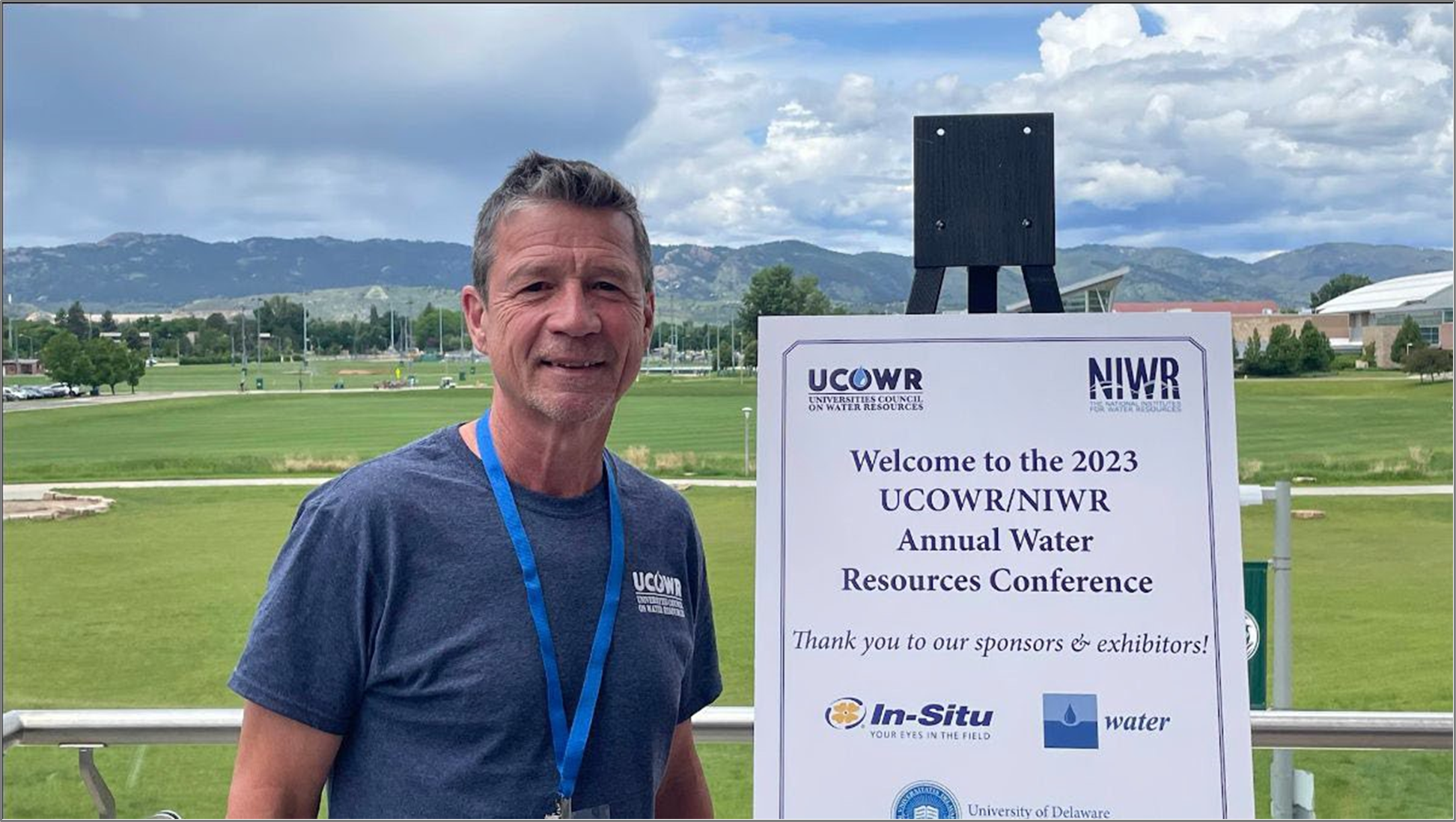
Newly inducted President Gerald Kauffman at the UCOWR Annual Conference on June 14, 2023, at Colorado State University in Ft. Collins, CO.
Delaware is the First State and has had a prominent presidential role in leadership lately. After all, a Delaware resident leads the nation and indeed the free world. As one of the million residents in our small state, I am even more aware now of our standing in the nation and worldwide. You could also say that the UDWRC is “presidential” and indeed we are noted as a national leader in water resources research, education, and public service.
UDWRC is a Congressionally chartered water research institute: Established on-campus in 1965 in the year after Lyndon Baines Johnson signed the Water Resources Research Act (WRRA) of 1964, the UDWRC is one of the 54 Congressionally chartered National Institutes for Water Resources (NIWR) supported by the Department of Interior and U.S Geological Survey at land grant universities in the 50 states, D.C., and three island territories of Guan, Puerto Rico, and U.S. Virgin Islands.
UDWRC top ranked in the nation by USGS: The UDWRC is recognized as “exceptional” in support of our students at Delaware universities. Per the Water Resources Research Act of 1984, the Secretary of Interior and Director of the U.S. Geological Survey informed the President of the University of Delaware by letter that the UDWRC is “unique nationally” and its collaborations are “impressive” amounting to a “high” rating and top 12 ranking nationwide among the 54 land grant universities. The five-year evaluation of the 54 National Institutes for Water Resources (NIWR) at land grant universities that stretch from Maine to Micronesia noted that our institute: (1) Engages with universities/colleges around the state, (2) Has strong leadership on the part of the Institute Director, and (3) Facilitates research and information transfer closely tied to the water resources needs/issues of Delaware.
UD AWRA voted national student chapter of the year: Our national prominence in water is further cemented with news that the University of Delaware student section of the American Water Resources Association (UDAWRA) was voted for the 4th time as the national chapter of the year, a feat matched only by the University of Wisconsin and the University of Florida. Martha C. Narvaez is the faculty advisor of the nationally prominent UD student section of the AWRA.
American Water Resources Association (AWRA) 51st President: In 2015, Martha C. Narvaez was elected as the 51st President of the American Water Resources Association (AWRA). The AWRA was established in 1964 and with 25,000 members is the world’s largest water resources professional organization.
Brandywine Red Clay Alliance (BRC) 77th President: In 2021, Andrew R. Homsey was elected as the 77th President of the Brandywine Red Clay Alliance of West Chester, Pennsylvania which was established in 1945 as the oldest small watershed association in the United States.
Universities Council on Water Resources (UCOWR) 59th President: In June 2023 at the national conference at Colorado State University, DWRC director Gerald J. Kauffman was elected as the 59th President of the Universities Council on Water Resources (UCOWR) which represents the 80 water resources research and degree-granting institutions of higher learning in America. Established in 1964, the UCOWR board is composed of faculty from the University of Delaware, Texas A&M, Minnesota, Oklahoma State, Mississippi State, Penn State, Purdue, Virginia Tech, Kansas State, University of Hawaii, University of California Berkeley, Washington State, and Southern Illinois University.
June 2022
Drought is Drought and Flood is Flood, And Never the Twain Shall Meet
Dr. Gerald Joseph McAdams Kauffman, Jr., Director
University of Delaware, Water Resources Center
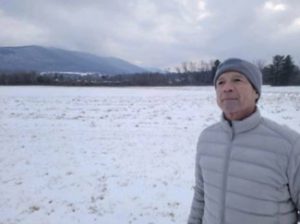 “Oh, East is East, and West is West, and never the twain shall meet.” Rudyard Kipling wrote this about colonialism and the state of world affairs in 1889, and one could apply it to the Russian invasion of Ukraine now. But in this case, we may apply it to the affairs of climate and water. While the West bakes in the worst drought in a millennium, the East has been deluged by the floods of Ida, the worst in two centuries along the Brandywine in Delaware and Pennsylvania. While drought and flood are at opposite extremes of the hydrologic cycle, they share the common causes of atmospheric warming and climate change. With Joe Biden (UD ’65) now in the White House as the 46th President of the United States of America, I want to share with you my views on a national approach to these global challenges because at the UDWRC we employ the “Delaware Way” to address climate and water problems.
“Oh, East is East, and West is West, and never the twain shall meet.” Rudyard Kipling wrote this about colonialism and the state of world affairs in 1889, and one could apply it to the Russian invasion of Ukraine now. But in this case, we may apply it to the affairs of climate and water. While the West bakes in the worst drought in a millennium, the East has been deluged by the floods of Ida, the worst in two centuries along the Brandywine in Delaware and Pennsylvania. While drought and flood are at opposite extremes of the hydrologic cycle, they share the common causes of atmospheric warming and climate change. With Joe Biden (UD ’65) now in the White House as the 46th President of the United States of America, I want to share with you my views on a national approach to these global challenges because at the UDWRC we employ the “Delaware Way” to address climate and water problems.
In Barcelona during the November 2009 negotiations for the Copenhagen climate conference, the executive director of the Stockholm International Water Institute precisely said that “climate change is water change.” This is explained in thermodynamics by the Clausius-Clapeyron relationship that for every 2 degrees Fahrenheit rise in temperature the atmosphere can hold 7 percent more water vapor. That is, global warming causes more evaporation, higher humidity, and increased water saturation in the atmosphere resulting in more wildfires, damaging storms and floods, searing drought, burying blizzards,
and melting of the glaciers leading to dwindling water supplies and sea-level rise. With the inauguration of President Joe Biden on January 20, 2021, and the 117th Congress, climate change is once again a top priority of the federal government, and we are seeing a brand new age—the 4th era of environmentalism—in the United States. The actions and deliberations on climate change ought to be apolitical and nonpartisan because after all to adapt an adage from my colleague at the University of Minnesota Water Resources Center, “clean water (and air) is neither red or blue, it is clear.”
In these new “Roaring Twenties” the four great challenges of the day are: (1) fight the pandemic, (2) revive the economy, (3) combat climate change, (4) and achieve racial justice. All four of these issues are intertwined in the disciplines of sustainable water and environmental policy. Clean water provides necessary hygiene to control the spread of the coronavirus. Clean water programs stimulate the economy and support high-paying green jobs. Finance of clean low-carbon energy combats climate change. Investment in polluted neighborhoods provides environmental justice to fight racism and provides good jobs for people of all races, creeds, and colors.
On March 22, 2016, President Obama invited 200 scientists to the White House Water Summit in Washington, D.C. On UN World Water Day, the White House hosted this first-ever national water summit to shine a spotlight on cross-cutting, creative solutions to solving the water problems of the day. Six years later, we’re looking forward to the next White House summit that could be a “Bretton Woods” of water and climate modeled on the 1944 economic summit where the 75 allied nations assembled in the White Mountains of New Hampshire to plan a new world order. Constitutionally, Delaware is the First State, and so it is in water. Sitting on the Delmarva Peninsula and surrounded on three sides by water, it is one of just three peninsular states, and with the C&D Canal, many consider it technically to be an island. At a mean elevation of only sixty feet above sea level, Delaware is also the lowest state in the United States with one-fifth of its landmass in the floodplain and a beautiful and bounteous 130-mile coastline with the cleanest ocean beaches in the nation. But this profile leaves the state vulnerable to worsening coastal storms and accelerating sea-level rise, perhaps more than other states. The Diamond State is fortuitously situated by geography and hydrology between two great estuary systems in America, the Chesapeake and the Delaware, that support abundant ecology and a $16 billion water economy.
Twenty years ago, at the turn of the century, Delaware took action to address the critical water issues of the day in a collaborative manner of getting along known as the “Delaware Way.” In 2000, the Governor and General Assembly appointed the Water Supply Coordinating Council and a State Water Master that transformed water supply management in Delaware after the crippling drought of 1995–2002. The same
year a state law was passed creating the Delaware Nutrient Management Commission a voluntary program that allows farmers to modernize farms and reduce nutrient loads to the Delaware, Chesapeake, and Inland bays without overbearing regulation. Also in 2000, Bill Clinton signed the White Clay Creek National Wild and Scenic River Act advanced by Senator Joe Biden (D-DE) and Congressman Joe Pitts (R-PA) as a bipartisan interstate approach to preserve the watershed in Delaware and Pennsylvania that supplies drinking water to 200,000 people or a full one-fifth of the population of the First State. Since then, Delaware has created a Division of Climate Change and Energy in the Department of Natural Resources and Environmental Control (one of the first in the nation) with a focus on climate change, sea-level rise, and clean energy. Delaware enacted these water and climate programs a generation ago and this cooperative way of cleaning up the environment is a model available to the greater United States.
______________________________________________________________
October 11, 2020
Everyone is Equal on this Blue Earth
I wish to refer you to the enclosed UDWRC FY21 work plan that Martha, Nicole, Andrew, and I have crafted to direct our efforts at maximum efficiency in this time of great challenges during the global pandemic and at long last our racial awakening. I am writing here from the Biden School, a place of great hope and feeling that if we stick together and learn about the social and physical sciences and treat people with decency, civility, and diversity in background and opinion that this world will be alright again and it shall be again – by next January.
https://www.wrc.udel.edu/ | https://www.wrc.udel.edu/wrc-mission/
As school resumed this fall, the health of everyone we work with is of paramount importance as we fight this pandemic.
We think our fieldwork in the fall along the White Clay Creek National Wild and Scenic River near Newark and Brandywine River in Wilmington can be safely conducted by our research students distancing and with masks and we have submitted our research plan to the University for approval.
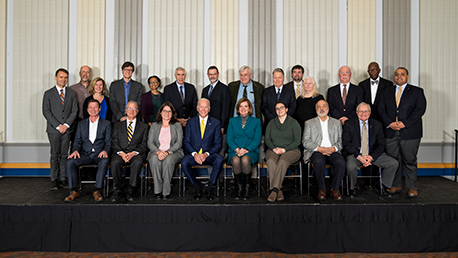
University of Delaware, Joseph R. Biden, Jr. School of Public Policy & Administration
With support from Sec 104b of the Water Resources Research Act of 1988 and the appropriation by Congress this fiscal year through the U.S. Department of the Interior and U.S. Geological Survey we are able to provide for the funded water resources research of 17 undergraduate and graduate students to examine the critical water issues of the day in Delaware and the mid-Atlantic region. So we are forging on. In Delaware and on campus we receive excellent guidance from the offices of the Governor and UD President about safe practices to stay healthy and we are committed to following these practices and most importantly wear masks when inside and out. I am tracking the science journals that indicate there are 126 different research initiatives around the world to develop a COVID19 vaccine and my bet is on the impressive young scientist at Oxford, entirely appropriate to follow in the footsteps of Edward Jenner!
I have been too reticent about this but with my heart breaking with the shootings in Kenosha, Wisconsin a place I used to work as a municipal engineer 30 years ago I just cannot be silent no more so I wish to speak. With regard to our racial awakening and indeed my own personal reckoning, I have thought about this every day and looked into the mirror and we need to do better – much, much better – Black Lives Matter! The scales are off my eyes now and at long last the stage is set for true racial equality where indeed all of humanity is created equal with certain unalienable rights endowed by our creator under the laws of nature. It’s time to amend the Declaration of Independence. I have long believed that and was taught that in my family by my aunt Sister Anne Virginia who taught me selfless love and lovingly brought me books to read as a 5-year old in Port Richmond in Philadelphia and at St. Cecilia’s and Bishop Eustace Prep. in Pennsauken, NJ but until now have not fully understood it because how could I am I am white and descended from Irish, Scot, and Welsh tribes with some Alsace thrown in and I am learning from my DNA that my Irish ancestors from Philadelphia fought and died to end slavery during the Civil War but they probably didn’t fully know what they were fighting for then. But now I am beginning to grasp it and it is time to do something about it. The UDWRC will become more diverse, we will bring on more scientists and students of every color from Delaware and America and from every corner of the globe. When I pass the baton my successor will be a woman and our ranks will be more representative of society in creed, race, and color. This is our mission.
Three years ago I requested that our homepage fly the message from Amos 5:24 and MLK, Jr. that reminds us to “let justice roll on like a river, righteousness like a mighty stream” and these are the words that we live by and will continue to live by. I grew up in Pennsauken, NJ just blocks from the border of Camden on the Delaware and remember the riots of 1969 just a couple blocks from my school yard at St. Cecilia’s and my mother’s and father’s pain that they tried to hide from me the year before when Dr. King and RFK were shot. I recoiled at the white supremacist march on Charlottesville and I swear that it will not happen here in Newark. I was taught to fight racism wherever it raised its ugly head up but it’s not enough and so now I look back on my life almost a half century ago when as a young guy learned about true courage from the amazing Olympians of Mexico City 1968.

200 M Medal Stand at the 1968 Mexico City Olympics
How do we achieve true racial equality? I don’t know if I was looking for answers like that as a teenager the year before going up to Rutgers and perhaps didn’t even know how to ask the question then. During the summer of 1977 my track coach was Larry James (the Mighty Burner) who ran at Villanova and was the AD at Stockton State down near Atlantic City and in the 1968 Mexico City Olympics he ran 43.97 and won the silver in the 400m and gold in the world record 4×400 relay and his teammates were three amazing men, Lee Evans, John Carlos, and Tommie Smith. I met them one day at a training camp in the Pine Barrens and they told me how they were ostracized and banned from their sport after raising their fists on the medal stand in 1968 and I was in awe of the world class athletes sitting with me but the beautiful thing is that they took this young white guy in and tried to tell me how it felt to be black and speak their minds while paying the ultimate price and banned from doing what they loved which was to run. But of course I could not understand it then but the shootings in Minnesota and Wisconsin are flashbacks in my mind back to then and the images are searing it into my senses now. These good men were a half century ahead of their time and their story is beautiful and right and true. I have their photo in my office at UD from 50 years ago with the Australian silver medalist Peter Norman who stood on that stand with them and opposed racism and supported his competitors and friends the black Americans and he too was ostracized when he went back to his country and never ran in the Olympics again. These young men black and white stood up to end racism and the old men took away the gift that God gave them, the ability to run fast! So I never fully appreciated the lessons of warmth and inclusion and forgiveness that Larry, Lee, John, and Tommie taught me during that brief time in the summer at the turn of the 80s but I look back to that lesson to help me understand now.
What is clear to me is that everyone is equal on this blue Earth, that Black lives matter, and that the only way forward is to stick together and choose love over hate. And I just want to let you know that my office at UD stands as a welcoming place of peace and tolerance and safety and I ache for my Black countrymen and those of all races who suffer from racism and bigotry in ways that I cannot begin to understand. I ask you please help me to understand.
I wish you all peace, health, and love.
Warmly,
Gerald McAdams Kauffman
May 2020
Delaware, The First State in Water
This has been a very good year in 2019 at the University of Delaware Water Resources Center (UDWRC) as I am pleased to report to you that the UDWRC has been recognized as “exceptional” in support of our students at Delaware universities. In accordance with the Water Resources Research Act of 1984, the U.S. Geological Survey informed the University of Delaware by letter that the UDWRC is “unique nationally” and its collaborations are “impressive,” a high rating granted by the US Department of Interior. The five-year evaluation of the 54 National Institutes for Water Resources (NIWR) at land grant universities that stretch from Maine to Micronesia noted that our institute: (1) engages with universities/colleges around the state, (2) has strong leadership on the part of the Institute Director, and (3) facilitates research and information transfer closely tied to the water resources needs/issues of Delaware.
Our very good grade on the USGS report card is due to our sterling water faculty and scientists who have advised over 250 students in research and on-the-job training for careers that address the critical water issues of the day in Delaware such as coastal flooding, water pollution, and climate change.
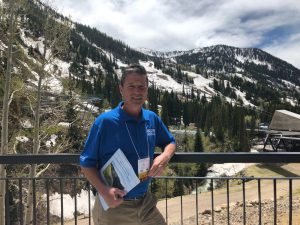
DWRC Director Gerald Kauffman installed to the Board at the annual Universities Council on Water Resources (UCOWR) conference in Snow Bird, Utah.
Our national prominence in water was further cemented this year with the news that the University of Delaware student section of the American Water Resources Association was voted for the 4th time as the national chapter of the year, a feat only surpassed by the University of Wisconsin and University of Florida.
I am also grateful to have been elected in June 2019 to a three-year term to the Board of Directors of the Universities Council on Water Resources (UCOWR) at the annual meeting along Little Cottonwood Creek, Utah. My fellow UCOWR board members include faculty from Oklahoma State, Mississippi State, Penn State, Purdue, Virginia Tech, Kansas State, Delaware, Hawaii, Cal Berkeley, Washington State, and Southern Illinois. What a great group of water scientists and even better people too!
Established on-campus in 1965, the UDWRC is one of the 54 Congressionally-mandated National Institutes for Water Resources (NIWR) supported by the Department of Interior and US Geological Survey at land grant universities throughout the US by the Water Resources Research Act of 1984. Delaware was the first state to sign the Constitution in 1787 and now as we enter our 55th year on campus in 2020, we are a “First State” in water as well.
December 2018
Why Study Water?
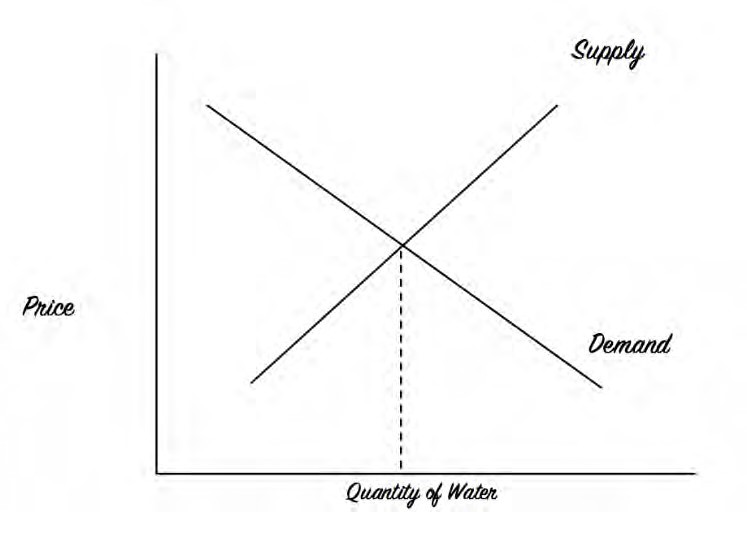
The old supply and demand curves don’t quite capture the true value of data and knowledge developed by the NIWR universities.
Why study water? Because it’s not just good for our ecology, it’s also the foundation of our economy. Established on campus in 1965 after Lyndon Baines Johnson signed the Water Resources Research Act (WRRA) during the golden era of water resources in the United States, the University of Delaware Water Resources Center (DWRC) is one of 54 National Institutes for Water Resources (NIWR) situated at land grant universities stretching across the Atlantic and Pacific from Maine to Micronesia. The 54 NIWR institutions of higher learning have graduated over 25 million alumni, many who hold jobs in the sciences, engineering, arts and humanities (STEAM) that support our national economy. We’re finding that the byproducts of our NIWR universities – data and knowledge – are priced differently and worth much more now in the new economy and the old supply and demand curves just don’t quite capture the true economic value of water.

DWRC Director Gerald Kauffman (right) with Associate Director David Shields (Brandywine Conservancy), President & CEO Collin O’Mara (National Wildlife Federation), and Executive Director Jim Jordan (Brandywine Red Clay Alliance) at the Bi- State Solution: Clean Water in the Brandywine-Christina Watershed conference in Mendenhall, PA on May 3, 2018.
The WRRA/NIWR research program invests in water resources that support a hundred billion dollar economy in the United States. The American Water Works Association (AWWA) calculated the U.S. gains $220 billion in economic activity and generates 1.3 million jobs by investing in water and wastewater infrastructure. Every new water sector job adds an additional 3.7 jobs to the U.S. economy and every dollar invested in infrastructure generates $6.00 in returns. In 2005, surface waters gaged by the USGS totaled 260 billion gallons per day for irrigation, industry, thermoelectric power, and drinking water uses with an instream value estimated by the University of Delaware of $21 billion. Ecosystem services and wetland habitat in National Wildlife Refuges maintained by the U.S. Fish and Wildlife Service totaled $27 billion in 2008 dollars. The U.S. Fish and Wildlife Service estimates clean water habitat supports $157 billion in annual expenditures including $46 billion for fishing, $35 billion for hunting, and $76 billion for bird/wildlife watching.
The Outdoor Industry Association estimates the outdoor recreation economy totals $140 billion nationally for water sports such as boating, paddling, and sailing. The University of Delaware found the Delaware River in Delaware, New Jersey, New York, and Pennsylvania supports $22 billion in annual economic activity and 600,000 direct/indirect jobs. The University of Maryland estimated the nation’s largest estuary, the Chesapeake, supports a trillion-dollar economy. The Nature Conservancy concluded the Colorado River drives a $1.4 trillion economy and 16 million jobs in California, Arizona, Nevada, Utah, Colorado, New Mexico and Wyoming or 10% of the U.S. gross domestic product (GDP). Investments in NIWR universities such as the University of Delaware by federal, state, and local governments are paying off handsomely in terms of jobs, careers, and GDP.
June 2017
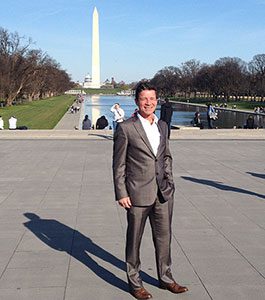
Gerald Kauffman attends World Water Day Reception after the White House Water Summit near the Lincoln Memorial and the U.S. Institute for Peace at the George P. Schultz Great Hall.
2H2 + O2 = 2H2O. Q = VA. Q = ciA
These are the scientific equations that guide the movement of dihydrogen monoxide on Earth. Water is the most valuable chemical in society and it is one of the few compounds in nature that exists in the three forms of matter: solid, liquid, and gas. It’s been said that water always flows downhill by gravity, yet it flows uphill toward money. My professor at Rutgers taught us that science is rational, linear, and logical yet policy (or politics) can be irrational, nonlinear, and chaotic. Maybe this explains what is going on these days.
In the week after the November 2016 election, I drove north from sea level in Delaware through the Schuylkill Valley and up and over the ridge through the Appalachian coal fields on the way to the Bucknell symposium on the Susquehanna River. And in towns like Frackville and Minersville, there was the election, downtowns tilted away from the past with economies shackled by the future. And after descending through the valley to the campus by the river on the other side, I realized that the quest for knowledge is an undeniable truth. Science and the classroom have always brought hope for a brighter future to towns just like these throughout America.
So for the first time in 30 years I went to a protest and took the train down from UD to DC to the March for Science on Earth Day on April 22, 2017. Emerging from Union Station I was proud to see on the right the Delaware flag, representing the First State in the Union. It was raining, with lots of water vapor, a perfect day for science. I rode the Citibike over to briefings at the American Association for the Advancement of Science (AAAS) and American Geophysical Union (AGU). A million scientists Subscribe Past Issues Translate RSS marched from the Washington Monument, past the White House, and up Constitution Avenue by the Smithsonian museums on the National Mall then over to the Capitol. I never saw science so strong. We marched with kids cured of cancer, biology teachers, physicians, nurses, teachers, a 95-year old astrophysicist, mobilized citizen scientists. You couldn’t help get the feeling that there will be more scientists in D.C. by 2018.
At UD we are fortunate to be one of the 54 National Institutes for Water Resources in a science network that stretches from Maine to Micronesia at land grant universities in the 50 states, D.C., and the three island territories of Guam, Puerto Rico, and U.S. Virgin Islands. The 54 NIWR colleges educate over a million students annually and have over 10 million alumni from throughout the U.S. and the world. Over the last 15 years, the DWRC has supported the water research of over 250 young scientists and engineers who have gone on to productive careers in society. With the start of the fall 2017 semester in September, we are excited to be part of the Biden School of Public Policy and Administration and look forward to working with Professor Biden on the cross-cutting environmental sustainability issues of the day.
These are turbulent times. Environmental budgets are being cut. Science funding is under scrutiny. Natural-born rights are being challenged. Yet with all this uncertainty, it’s reassuring to know that water always obeys the universal laws of nature. And with science as our foundation, at the University of Delaware Water Resources Center we search for new knowledge and train future scientists in an unfettered way with openness to the policies and viewpoints of all. As I tweeted before, I embrace all on Earth who seek peace and love in this nation of inalienable rights that each are born with and no government may take away. And as they say in the NIWR, water is clear–it is neither red or blue.
October 2016
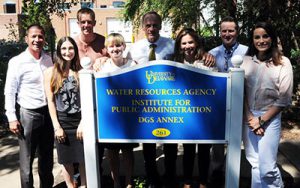 During the century-ending drought of 1999, the State Geologist once informed the Governor’s Drought Advisory Committee that “a drought always ends when it rains.” While no one can predict the future and our warming atmosphere makes it harder to forecast the weather, this adage is always true. This summer we sweated through the hottest August on record in Delaware in 122 years dating to 1895 and our drinking water streams such as the Brandywine have declined to the lowest levels since the record drought of 2002. The Delaware Water Supply Coordinating Council is watching this closely and a drought watch may be in the offing unless we receive tropical moisture in the name of Matthew, Nicole, or Otto.
During the century-ending drought of 1999, the State Geologist once informed the Governor’s Drought Advisory Committee that “a drought always ends when it rains.” While no one can predict the future and our warming atmosphere makes it harder to forecast the weather, this adage is always true. This summer we sweated through the hottest August on record in Delaware in 122 years dating to 1895 and our drinking water streams such as the Brandywine have declined to the lowest levels since the record drought of 2002. The Delaware Water Supply Coordinating Council is watching this closely and a drought watch may be in the offing unless we receive tropical moisture in the name of Matthew, Nicole, or Otto.
Delaware relies on concordant relationships with our Federal water agencies and neighboring states as a full two thirds of the First State’s drinking water flows from four streams that roll down from the Piedmont foothills in Pennsylvania and Maryland across William Penn’s 1682 arc into the Coastal Plain of Delaware. Since the UD campus lies by the banks of one of these streams, the White Clay Creek National Wild and Scenic River, our Delaware Water Resources Center (DWRC) students have an ideal outdoor living laboratory at their doorsteps to carry out their research on droughts and floods. On a drought-like August day, our senior Senator Tom Carper, a ranking member of the Senate Public Works and Environment Committee, stopped by the DWRC offices to discuss these critical water resource issues with our water science and policy and environmental studies students. As we enter the 2017 Water Year on October 1st, we reflect on our strategic thinking about how to provide more cohesive research opportunities for budding water scientists and students here in Delaware.
Therefore, for the first time in 40 years, we are pleased to announce the merger of the Delaware Water Resources Center (est. 1965) with the Water Resources Agency (est. 1977). You can read more about the fluidity of this synchronization at our new website. Do you remember Adam Smith who discussed the invisible hand of economics? Well back in 1776 he also wrote about the diamond-water paradox. Water (and the people who study it) are precious resources, that’s always been true too!
March 2016
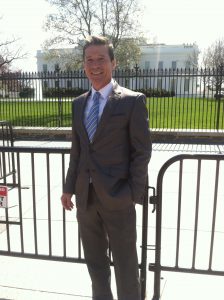 Twitter, CSPAN, the New York Times…water is increasingly in the news these days. From the California drought to blizzards and coastal flooding in Delaware, not to mention the Flint River crisis, water issues are impossible to avoid. Through all the noise of the election, the economy, and even March Madness, water is “bubbling up to the top” for the public as well as top officials from governors to the President. I saw this first-hand when invited to represent the University of Delaware and Delaware at the White House Water Summit on March 22, 2016, which coincided with World Water Day.
Twitter, CSPAN, the New York Times…water is increasingly in the news these days. From the California drought to blizzards and coastal flooding in Delaware, not to mention the Flint River crisis, water issues are impossible to avoid. Through all the noise of the election, the economy, and even March Madness, water is “bubbling up to the top” for the public as well as top officials from governors to the President. I saw this first-hand when invited to represent the University of Delaware and Delaware at the White House Water Summit on March 22, 2016, which coincided with World Water Day.
These national water issues were also the focus of the National Institutes for Water Resources (NIWR) meeting this past February in Washington, DC, which Martha Narvaez and I attended with our colleagues and the directors of water resources institutes at 48 other land grant universities stretching from Maine to Alaska to Guam and the U.S. Virgin Islands. We spent much of our time discussing these national water issues with scientists from NOAA, USDA, Department of the Interior, EPA and the US Army Corps of Engineers.
It is clear that it is indeed in the national interest to address these water crises through the research and education programs supported through the USGS and the National Water Resources Research Program created by LBJ and Congress in 1964. At the DWRC, I am glad to report that we are doing our best to train the next generation to address these profound water resources issues that have great impact on the economy and ecology of the United States. At our February 29, 2016 special leap-day meeting of the DWRC Advisory Panel, we heard presentations on the work of our graduate research assistants and undergraduate interns supported by DWRC, who put on display a very impressive body of research.
Over the last year we have sponsored the research of 20 students who joined with faculty and scientist advisors across four colleges of the University to work on addressing the water resources problems of tomorrow. I am happy to report that the future of water resources is in good hands with this cohort of budding water scientists, and that the DWRC is poised to address the water challenges in Delaware, the Delmarva, and indeed nationally and globally. Although Delaware may be small, we are always the First State for water resources.
November 2015
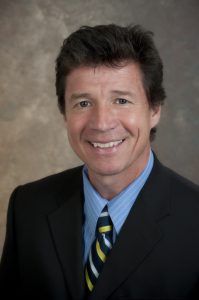 Twenty fifteen has indeed been a watershed year for water resources in the Diamond State.The Delaware Water Resources Center is celebrating the Golden Anniversary of our founding in 1965, just a year after Lyndon Baines Johnson worked with Congress and signed the Water Resources Research Act that formed the 54 National Institutes for Water Resources (NIWR) at land grant universities in the 50 states, D.C. and the three island territories of Guam, Puerto Rico, and U.S. Virgin Islands. The DWRC Advisory Panel has recommended water resources research funding from the USGS that supports 18 undergraduate internships and 3 graduate assistantships to study with faculty and scientists from five colleges at the University of Delaware. In September, the University of Delaware was chosen to host the 3rd Annual Delaware River Forum sponsored by the Coalition for the Delaware River Watershed that highlighted over $35 million in investments by the William Penn Foundation to 40 nonprofits and universities to protect and restore the watershed that provides drinking water to 5% of the population of the United States. Accepting the gavel from our NIWR colleague and outgoing President Dr. John Tracy (Director of the University of Idaho Water Resources Research Center), the University of Delaware Water Resources Center’s Martha Narvaez was inducted on November 18, 2015 as the 50th President of the American Water Resources Association at the AWRA annual conference in Denver, Colorado. Completing the flow of good news, past president and geography doctoral candidate Asia Dowtin and current president and Water Science and Policy graduate student Sandra Petrakis accepted the award in Denver on November 15, 2015 as the University of Delaware was recognized as 2015 outstanding AWRA student chapter at the annual AWRA conference in Denver, Colorado. National champs! I wonder what the next ten years will bring for us here at the DWRC. Diamonds anyone?
Twenty fifteen has indeed been a watershed year for water resources in the Diamond State.The Delaware Water Resources Center is celebrating the Golden Anniversary of our founding in 1965, just a year after Lyndon Baines Johnson worked with Congress and signed the Water Resources Research Act that formed the 54 National Institutes for Water Resources (NIWR) at land grant universities in the 50 states, D.C. and the three island territories of Guam, Puerto Rico, and U.S. Virgin Islands. The DWRC Advisory Panel has recommended water resources research funding from the USGS that supports 18 undergraduate internships and 3 graduate assistantships to study with faculty and scientists from five colleges at the University of Delaware. In September, the University of Delaware was chosen to host the 3rd Annual Delaware River Forum sponsored by the Coalition for the Delaware River Watershed that highlighted over $35 million in investments by the William Penn Foundation to 40 nonprofits and universities to protect and restore the watershed that provides drinking water to 5% of the population of the United States. Accepting the gavel from our NIWR colleague and outgoing President Dr. John Tracy (Director of the University of Idaho Water Resources Research Center), the University of Delaware Water Resources Center’s Martha Narvaez was inducted on November 18, 2015 as the 50th President of the American Water Resources Association at the AWRA annual conference in Denver, Colorado. Completing the flow of good news, past president and geography doctoral candidate Asia Dowtin and current president and Water Science and Policy graduate student Sandra Petrakis accepted the award in Denver on November 15, 2015 as the University of Delaware was recognized as 2015 outstanding AWRA student chapter at the annual AWRA conference in Denver, Colorado. National champs! I wonder what the next ten years will bring for us here at the DWRC. Diamonds anyone?
August 2015
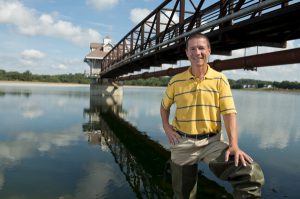 In January 2015, Dr. Jerry Kauffman was named the third Director of the Delaware Water Resources Center. Dr. Kauffman succeeds Dr. Tom Sims, Deputy Dean of the University of Delaware’s College of Agriculture and Natural Resources who skillfully served as the second Director of the DWRC for a decade and a half and made a real and substantial difference in the careers and lives of many students, faculty, and staff who conducted research in water science and policy here at the University of Delaware.
In January 2015, Dr. Jerry Kauffman was named the third Director of the Delaware Water Resources Center. Dr. Kauffman succeeds Dr. Tom Sims, Deputy Dean of the University of Delaware’s College of Agriculture and Natural Resources who skillfully served as the second Director of the DWRC for a decade and a half and made a real and substantial difference in the careers and lives of many students, faculty, and staff who conducted research in water science and policy here at the University of Delaware.
 Maria Pautler
Maria Pautler
Research Associate III
(DWRC Program Coordinator 2000-2017)
302-831-0847
mpautler@udel.edu

